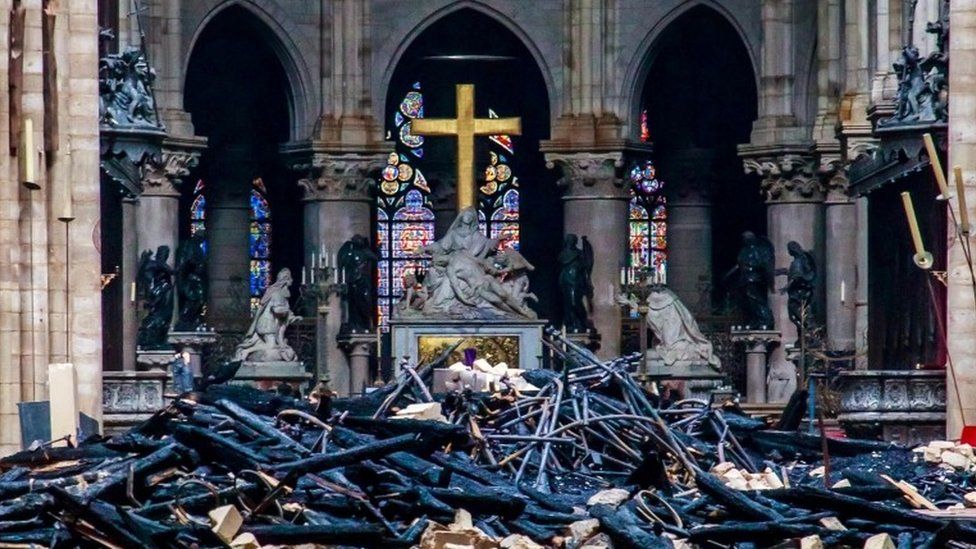The world was moved when news spread that the Notre Dame cathedral in Paris was on fire. For several hours the flames consumed the roof, which was declared a total loss, as were the Western Rose Window (built in 1225) and the North and South Rose Windows (both from 1250). A team of 400 firefighters—practically the entire Paris fire department—combated the blaze until it subsided. Several artworks in the cathedral were rescued.
Afterward, Macron announced: “We’ll rebuild Notre Dame together”; In times of crisis and social unrest, the French bourgeoisie always calls for national unity. Macron is trying to use this disaster to justify the brutal repression against the Yellow Vests movement; week after week, people are beaten and gassed by the Macron government. After more than 20 weeks of protests, Macron’s approval rating has sunk to just 30 percent.
Within the first 24 hours, billionaires promised to donate 600 million Euros for the restoration of the cathedral. The policies of Macron and previous French presidents allowed a handful of billionaires to accumulate incredible wealth. So, the fortune they so “generously” offer—which for them is only pocket change—comes from the worst exploitation of workers in France, as well as sowing death and destruction throughout the world.
In Yemen, for example, French-made weapons are destroying cultural heritage and historical mosques, and murdering countless people. The looting of historical artifacts throughout the region was supported by French imperialism: France was among the countries that formed the coalition that overthrew Saddam Hussein in Iraq, leading to the plundering of museums all over the country. And that is not to mention the long legacy of destruction created by French imperialism.
The hypocrisy shown by the world’s elites in the face of the tragedy has been hard to stomach. Donald Trump was quick to offer “advice” for combatting the flames in Paris. Yet he has been completely silent as Black churches have been torched in the U.S. South by white supremacists. In countries where the Catholic Church is powerful, such as Mexico, some people were happy to see the flames spread. They claimed that the only good church was one in flames. Wouldn’t this fire weaken the reactionary institution?
History of the Cathedral
This is not the first time Notre Dame has been damaged and in need of restoration. Built in the Gothic architectural style, the cathedral honors the Virgin Mary (its name full name is “Cathedral of Our Lady of Paris”). Its first stone was set in 1163 under the reign of King Louis VII (1137-1180), of the House of Capet, and was completed almost two centuries later in 1345. It has stood, then, for almost 800 years. In that time, it has undergone several redesigns, including a baroque restoration under King Louis XIV (1643-1715). Each year from 1630 to 1707, the goldsmiths guild produced a painting to adorn the interior—77 large paintings in total, including works by Laurent de La Hyre and Sébastien Bourdon.
During the French Revolution (1789), however, the building was damaged and vandalized by the masses. The statues of the Kings of Judah were beheaded, for example, because they were thought to represent French kings. Later, Napoleon was crowned emperor inside the cathedral. During the 19th century, the building was in a state of disrepair, and in his book “Our Lady of Paris” (also known as “The Hunchback of Notre Dame”), Victor Hugo tried to raise awareness of its uniqueness. Thus, in 1844, under the guidance of architects Eugène Viollet-le-Duc and Jean-Baptiste-Antoine Lassus, construction began on the central spire (which collapsed during the fire) and was finished in 1860.
Notre Dame’s historical importance lies in the fact that it survived the destruction of the other major medieval buildings that were torn down by Napoleon to make way for the “modernizing” project of Georges-Eugène Haussmann, which would give life to the “new Paris”: an urban center with many connecting streets and crossroads. This was an urban renewal project focused on destroying the Gothic medieval architecture and burying the image of historical Paris—one of misery and overcrowding.
Napoleon III would continue the work of his uncle, and in 1852, after the Spring of Nations of 1848, he ordered a general reconstruction of Paris. By his order, majestic and grandiose avenues were built, but behind the apparently aesthetic improvement of the streets lay a strategic objective: preventing the proletariat from building barricades as it had done four years earlier thanks to the narrowness of the old streets and alleyways. Notre Dame stood tall despite both French emperors’ efforts to remake the capital city.
During the 20th century, Notre Dame survived two world wars and the Nazi occupation in which General Dietrich von Choltitz directly defied Hitler’s order to set the city ablaze, and in 1965, the city once again made headlines when Roman catacombs and the sixth-century Merovingian cathedral were discovered. In the words of British Marxist Alex Callinicos,
You can say, correctly, that the medieval cathedrals were a crucial part of the ideological apparatuses of European feudalism. But they were also the works of collective art, the result of the anonymous labours of many skilled artisans, very different from the Romantic ideal of art as the expression of the individual subjectivity of a solitary genius. I’ve long thought that in this respect they anticipate what art would be like in a communist society. But, less pretentiously, one could just say that Notre Dame is old and beautiful and part of what makes Paris Paris. It’s one of the things that makes Paris so different from London, the survival of a medieval centre.
The Building Burned Down, Not the Institution
Is everything lost? Fortunately, no. Not only because the cathedral’s artworks were taken to safety but also because there are countless pictures, replicas, and re-creations of the cathedral and its interiors. There are at least two replicas of the building in North America and another one in Belgium, as well as a digital re-creation made by Caroline Miousse for the video game Assassin’s Creed Unity. So it is safe to say that reconstructing Notre Dame will not be too difficult.
Despite all this, however, humanity has lost a valuable piece of world history. Yet some people on social media celebrated the fire, circulating the well-known anticlerical phrase “The only church that illuminates is the one that burns.”
It is not hard to understand the source of these thoughts. It is true that the Catholic Church is an obscurantist and oppressive institution, one that has covered up cases of sexual abuse of minors by priests, allied with the most terrible dictators of history, saw no problem in giving babies for adoption in South America before the dictatorships executed their mothers, and committed countless other crimes against the popular and downtrodden sectors of society. They plundered indigenous societies and still have the gold, silver and gems mined by the hands of the poorest people in the world.
But a church is not the same as the Church; although this institution has lasted for over a millennium and has been an ally of dominant classes, the fire in a cathedral, as much of a loss as it may have been, does not diminish the power and influence the institution has over the population, just as throwing a stone and breaking a window in a Starbucks coffee shop does not diminish the millionaire profits the multinational company makes from the sweat of its workers. So how should we think about religion and the church?
Marxism and Religion
Marxism has, since its inception, debated the problem of religion. One of Marx’s most well-known phrases is that “religion is the opiate of the masses” (or, depending on the translation, “the opium of the people”), but the full quote is less well known, and even less so is the context in which he wrote it. During Marx’s life, opium was the cause of conflicts—such as the Opium War in China. It was also used by doctors as a powerful painkiller and by mothers to keep their children quiet, and it was known to be the source of hallucinations. It is likely Marx meant the metaphor in all these senses:
Religious suffering is, at one and the same time, the expression of real suffering and a protest against real suffering. Religion is the sigh of the oppressed creature, the heart of a heartless world, and the soul of soulless conditions. It is the opium of the people.
Although Marx saw the role of religion as keeping the working class and society at large in a passive state, he never supported the idea of forbidding religion and tearing down churches and altars. Decades later, Lenin himself shared this position and explained it in a 1909 text titled “The Attitude of the Workers’ Party to Religion”:
We must combat religion—that is the ABC of all materialism, and consequently of Marxism. But Marxism is not a materialism which has stopped at the ABC. Marxism goes further. It says: We must know how to combat religion, and in order to do so we must explain the source of faith and religion among the masses in a materialist way. The combating of religion cannot be confined to abstract ideological preaching, and it must not be reduced to such preaching. It must be linked up with the concrete practice of the class movement, which aims at eliminating the social roots of religion.
Both Marx and Lenin thought the key to combating religion, superstitions, and ignorance was patient explanation, without resorting to persecuting people for their beliefs. Otherwise, Marxists would join in the rhetoric of those who, under a “republican” and anti-theist façade, celebrated Charlie Hebdo’s Islamophobic cartoons. Or, even worse, we would be little different from the Islamic State, which destroyed countless buildings of Babylonian heritage in the Syrian city of Palmyra.
Leon Trotsky’s words point in the opposite direction of those who think “the only church that illuminates is a burning church.” In a 1926 text titled “Culture and Socialism,” Trotsky says,
Art is one of the ways in which man finds his bearings in the world; in this sense the heritage of art is not distinguished from the heritage of science and technology—and it is no less contradictory than them. … The art of past centuries has made man more complex and flexible, has raised his mentality to a higher level, has enriched him in an all-around way. This enrichment is a precious achievement of culture. Mastery of the art of the past is, therefore, a necessary precondition not only for the creation of new art, but also for the building of the new society, for communism needs people with highly developed minds. However, can the art of the past enrich us with an artistic knowledge of the world? It can, precisely because it is able to give nourishment to our feelings and to educate them. If we were groundlessly to repudiate the art of the past, we should at once become poorer spiritually.
Ultimately, the Notre Dame cathedral, like many other grandiose constructions of the past, represents a past built majestically by the hands of thousands of “invisible” and enslaved workers—the true forgers of peoples’ history.











